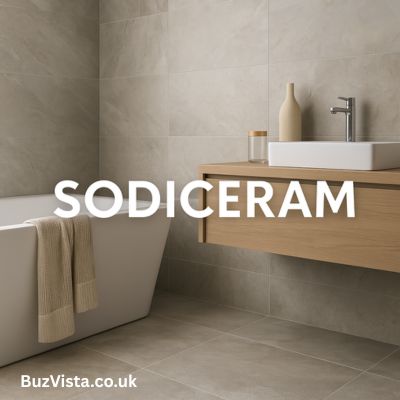In recent months, “sodiceram” has emerged as a trending keyword in interior-design blogs, tile forums, and aspirational home improvement content. But what is sodiceram? Is it a breakthrough material, a rebranded tile manufacturer, or a marketing buzzword? This article dives deep into the various narratives, claims, and realities of sodiceram—what’s credible, what remains uncertain, and how you can approach it smartly if you see it offered in your region.
Two Competing Narratives: Material or Brand?
When you first search “sodiceram,” you’ll rapidly encounter two distinct storylines. The first treats sodiceram as a specialized ceramic/porcelain material, often described as “sodium-infused” or “enhanced.” The second frames sodiceram as a tile/ceramic brand or distributor with roots in Europe. These narratives sometimes overlap in blog posts and marketing content, causing confusion.
- As a material concept, sodiceram is presented as a cutting-edge ceramic that delivers superior durability, low water absorption, thermal stability, and even environmental advantages.
- As a brand or business, sodiceram is referenced as a company (or former company) producing or selling ceramic tiles, with claimed histories in France or Portugal.
Because clear, authoritative documentation is limited in public search results, much of what circulates is derived from secondary blogs or retail-style writeups. Treat molecular or technical claims with caution unless backed by data sheets or independent lab testing.
What Claims Do You Commonly See?
Below is a breakdown of common claims in blog/consumer content, along with thoughts on plausibility and things to verify.
1. Sodium-based composition / “sodium infusion”
Many descriptions say sodiceram incorporates sodium compounds (e.g. sodium oxides or silicates) into a standard ceramic matrix (silica, alumina, clays), then sintered under controlled conditions to improve densification. A few narratives suggest this yields better bonding between grains, less porosity, and enhanced resistance.
Skeptical lens: Traditional technical ceramics (porcelain, stoneware) already operate at very high density and low porosity. Adding sodium or modifying melts may introduce risk (e.g. altering thermal expansion, introducing glassy phases). Unless a manufacturer discloses exact composition, firing regime, and test metrics, such claims remain speculative.
2. Low water absorption / near-zero porosity
Given that many tile standards classify porcelain as <0.5% water absorption, some sodiceram claims go further: absorption approaching 0.1% or even “zero.” Bloggers position this as making it especially suitable for bathrooms, wet zones, exteriors.
What to check: Ask for independent lab reports measuring absorption, ASTM or ISO compliance, freeze–thaw performance, and long-term performance under moisture cycling.
3. Enhanced mechanical & wear properties
It is frequently claimed to resist abrasion, scratching, and lifetime wear better than conventional tiles—often marketed to commercial spaces, hotel lobbies, and high-traffic areas.
What to verify: Look for abrasion ratings (PEI classes, Mohs hardness, or taber abrasion testing). Understand the difference between surface glaze hardness and bulk material strength.
4. Thermal / heat performance
Some writeups suggest sodiceram handles temperature swings better—less prone to thermal shock, less expansion/contraction, and suitable even for underfloor heating or semi-outdoor use.
What to verify: Coefficient of thermal expansion, dimensional stability at heat/cold cycles, temperature gradient behaviour—all ideally from lab data.
5. Sustainability & longevity
Blogging sources often emphasize a long service life—“several decades with minimal maintenance”—and sometimes lower carbon emissions or eco-friendly manufacturing. Some also mention that because of its durability, replacement frequency declines, thereby reducing embodied energy over time.
Caution: Without a published life-cycle assessment (LCA) or environmental product declaration (EPD), such statements are marketing claims. Ask whether recyclability, energy inputs, emissions, and waste are quantified.
6. Versatile finishes & formats
In buyer’s guide style posts, sodiceram is claimed to be available in many finishes—polished, satin, grip/anti-slip—and in various formats (mosaic, large slabs, decorative shapes). Some text suggests it can mimic natural stone, concrete, marble, or wood.
Reasonable expectation: Many premium ceramic lines offer these variations. The differentiator still is whether the underlying material truly meets “advanced” criteria or simply is a branded line with marketing.
Unpacking the Brand / Business Angle
Parallel to the material narrative, many writeups treat sodiceram as a company or brand. Below is a synthesis of what appears in blogs, business directories, and historical references:
Origins & Geographical Associations
- Some sources position sodiceram as having a presence in France, particularly in a mid-size city (e.g. Reims). They refer to addresses and business directory listings tied to tile retail or ceramic distribution.
- In contrast, other narratives position sodiceram in Portugal, emphasizing European ceramic traditions and modern design.
Because there is no definitive official website or manufacturer’s technical archive surfaced in general search results, the business narrative remains murky. Some blog content even claims the brand ceased operations or restructured, though no archival verification is visible at present.
Product & Market Approach
Under the brand angle, sodiceram is often presented as a mid- to high-end tile line, targeting residential and commercial spaces. Its “unique value” is presented as the advanced material claims above. Many blog-style buyer guides use sodiceram as an example of a premium offering in flooring, wall tiles, and decorative cladding.
Challenges in verifying the brand story
- No assured, longstanding online presence or design catalog with technical pages emerged in popular indexed results.
- Many references to sodiceram come via SEO-style blogs (with repeating templates) rather than independent design trade publications.
- The brand stories sometimes conflict (France vs Portugal, still active vs defunct).
Hence, while using the brand narrative in your article is fine, it’s wise to couch statements as “claims observed in trade/consumer discourse” unless you independently confirm via business registries or archival documents.
Buyer’s Guide: If You Encounter Sodiceram Tiles
If you come across sodiceram tiles (in a showroom or online), here’s how to evaluate them sensibly:
1. Ask for technical data
Don’t rely on marketing blurbs. Insist on a data sheet specifying:
- Water absorption (percentage)
- PEI class or abrasion rating
- Slip resistance or R-class for wet areas
- Flexural strength / modulus
- Thermal expansion coefficient
- Guarantee or warranty terms
- Source / origin, and date of manufacture
If you get a lab or third-party test, that’s a strong positive signal.
2. Compare to existing standards
Even with advanced claims, the tile should still meet or exceed established standards (ISO, EN, ANSI). If “sodiceram” falls short of proven benchmarks, you may be better off with well-known certified brands.
3. Match finish to usage
If you prefer polished or glossy finishes, restrict them to low-moisture, low-slip zones (living rooms, bedrooms). Use matte, textured, or grip surfaces for bathrooms, wet zones, or exteriors (if specs allow).
4. Layout & installation
Because advanced ceramics are often stiff and less forgiving, precise leveling, proper subflooring, consistent joints, correct adhesives, and expansion allowances become more critical. Poor installation can degrade performance or cause failure even in a premium tile.
5. Aftercare & maintenance
If sodiceram truly exhibits low porosity, cleaning should be easier; regular mild cleaners should work, and staining should be minimal. Still, avoid harsh acids, heavy abrasives, or extreme thermal treatments unless manufacturer guidelines support them.
6. Longevity & replacement considerations
If you commit to sodiceram, ask about whether replacement tiles will remain available long-term. Even premium lines can be discontinued. Retaining some spare tiles is prudent.
Why the Hype—and Where Skepticism Is Healthy
Many blog/SEO content pieces echo very similar language around sodiceram—almost as if drawn from a shared template. This suggests that much of the visibility is marketing amplification rather than technical innovation. That’s not inherently bad, but it means:
- Claims must be interrogated.
- Absence of a solid origin or manufacturer site is a red flag.
- Real differentiation may only exist in a few verified product lines—others may be rebranded conventional ceramics.
Still, the hype is understandable if the concept resonates: a “next-generation ceramic” fits naturally into design aspirational thinking, especially when people clamor for low-maintenance, high-performance materials.
If sodiceram eventually becomes anchored to a legitimate manufacturer with credible R&D output, the storytelling will gain more substance. Right now, most writing is directional, not definitive.
Proposed Positioning & Recommendations for Writers/Marketers
If you plan to position sodiceram in your market or website:
- Frame it as a “premium/advanced ceramic concept or line” rather than declaring it a “scientific breakthrough.”
- Use language like “claims to deliver … ” or “marketing positions” unless you independently verify the data.
- Invite comparison: “Here’s how sodiceram claims stack up versus X-brand porcelain…”
- Include an FAQ or buyer’s checklist in your article to help readers assess credibility.
- If you can, secure one sample and commission independent lab testing to publish real data (this differentiates your content).
Sample Article (Full Narrative Style)
Sodiceram: Revolution or Re-branding of Conventional Ceramic?
In the world of interiors and architectural finishes, new names pop up regularly. Yet a few stir more curiosity than others—and sodiceram is one of those. Across blogs and buyer guides in 2025, sodiceram is championed as a next-generation ceramic with special enhancements. But when you scratch the surface, the clarity blurs.
On one hand, sodiceram is portrayed as a technical material—“sodium-infused, high-density, low absorption, superior wear resistance.” It’s positioned as ideal for kitchens, bathrooms, commercial spaces, even light exterior use. But if you seek its manufacturer’s specification sheets, you’ll often find only blog summaries. On the other hand, sodiceram turns up (in directories and lifestyle writeups) as a tile brand—sometimes rooted in France, sometimes in Portugal—but rarely producing a robust public trace of active production.
As a material concept, sodiceram’s claims of ultra-low porosity or enhanced strength invite interest—but also scrutiny. True performance in ceramics depends on precise raw mixes, high-temperature sintering, controlled shrinkage, and careful quality control. Marketing claims that exceed established tile standards deserve direct substantiation; they should be tested, compared, and independently verified.
From a purchase perspective, encountering sodiceram in a showroom should prompt you to ask for cold hard data. Demand water absorption numbers, durability tests, slip ratings, and warranty terms. If the product’s guidance and lab data align with its marketing, it might well be a higher-tier offering. If not, you risk overpaying a branded name for performance you could already find in known reputable lines.
Because many of the published references to sodiceram follow near-identical patterns, and because no definitive manufacturer site currently dominates search results, it’s wise to regard much of the “sodiceram hype” as aspirational. But that doesn’t mean the concept is without merit—just that the burden of proof lies with the supplier.
If, in your region (for example, in South Asia, Middle East, or Pakistan), you see sodiceram tiles, use due diligence. Compare them side by side with certified porcelain or vitrified options. Retain extra tiles for future repairs, and document performance over months or years. If the brand backs its claims with third-party testing, you’ll gain the confidence to integrate sodiceram into your projects.
In the journey of interior design and materials, whether sodiceram becomes a recognized technical name or fades as a marketing gloss depends on data, transparency, and real performance. As curious designers, homeowners, or specifiers, your scrutiny is your power.
(This article is published by (Buz Vista.)

